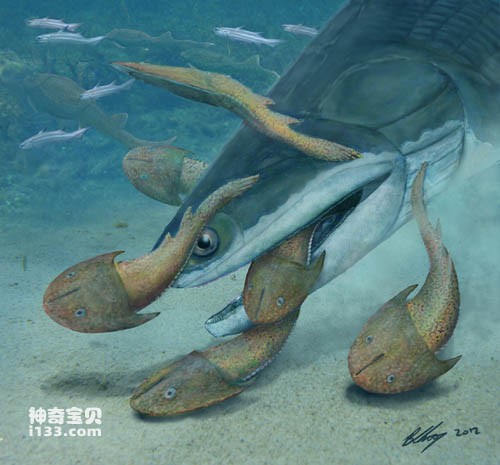Zhu Min's team from the Institute of Vertebrate Paleontology and Paleoanthropology, Chinese Academy of Sciences, reported in the "Nature Scientific Reports" published on June 12 that the largest vertebrate in the Silurian Period so far was named Megamastax. amblyodus) bony fish. Existing evidence shows that the blunt-toothed macrognathus 423 million years ago could reach a length of 1.2 meters and occupied a higher position in the food chain. This is another important discovery of the Silurian Xiaoxiang fauna in the Qujing area of Yunnan (after the Dream Ghost Fish and the Initial Holognathus). This discovery challenges the tradition that there were no large vertebrates before the Early Devonian Amesian. views, while prompting researchers to rethink the relationship between changes in oxygen levels and the evolution of vertebrates.

Restored picture of Macrognathus
After nearly eight years of continuous field investigation and excavation, Zhu Min and his research team have made several sensational scientific discoveries in the Xiaoxiang fauna in Qilin District, Qujing City, including a placoderm fish with a teleost-type marginal jaw— —Entelognathus primordialis, and the world’s earliest fully preserved bony fish—Guiyu oneiros, etc. Zhu Min said, "In this treasure house of Silurian fossils, even scattered bone fragments contain a wealth of scientific information. Although only two lower jaw and one upper jaw specimens of the blunt-toothed macrognathus reported this time have been found so far, , but detailed research on it has provided key evidence for the hot issues of the early evolution of vertebrates and paleoenvironmental evolution."
Changes in oxygen content in the atmosphere are a matter of concern in paleoenvironmental research. Paleoenvironmentalists believe that there was a significant increase in atmospheric oxygen content during the period from the late Silurian to the early Devonian. However, there are two different theoretical models regarding the exact timing of this oxygenation event. Geochemical evidence from molybdenum isotopes suggests this event occurred 400 million years ago during the Early Devonian Period, consistent with past fossil records. The traditional paleontological view is that the prosperity of terrestrial vascular plants led to an increase in atmospheric oxygen content, and the increase in atmospheric oxygen content allowed jawed vertebrates to develop during the Early Devonian Amesian period (408 million years ago to 393 million years ago). Years ago), they were able to enlarge their bodies and dominate the waters of the earth. Therefore, the Devonian Period is also called the "Age of Fishes."

Macrognathus fossil specimen
However, the discovery of a 423-million-year-old Silurian macrognathus has challenged the above view. The lower jaw of the blunt-toothed macrognathus is more than ten centimeters long. Based on the body proportions of the dream ghost fish and other completely preserved early bony fish, its body length should be more than 1 meter. The largest individual may have reached about 1.2 meters, which is far more than All Silurian vertebrates have been previously discovered, which refutes the conclusion that there were no large vertebrates before the Eamesian in the Early Devonian. Some recent paleobotanical studies have also shown that by the late Silurian, terrestrial vascular plants were already quite prosperous. These findings support the model of oxygen content changes shown by ancient ash evidence, that is, the increase in oxygen content in the Paleozoic occurred in the late Silurian period about 420 million years ago.
The jaw characteristics indicate that Macrognathus obtusa is a typical bony fish. The mandible is composed of two rows of bones. The outer edge of the mouth is a long strip of tooth bone, which is the bone that makes up the human lower jaw. The surface is covered with an entire row of bone tissue with countless pores. Immediately on the inside of the tooth bone is the coronal bone, which is composed of a series of bones arranged front and back. The shapes of the teeth growing on the inner and outer jaws are completely different: the dentary has several rows of fine, sharp teeth, while the coronal bone protrudes from eight much larger teeth with blunt tips. Researchers speculate that they apparently had different purposes. The outer teeth may have been used to capture and hold onto prey, while the large blunt teeth on the inner side were used to crush its hard shell.
Shelled brachiopods, bivalves and trilobites in the Silurian shallow sea in eastern Yunnan may all be the food of Macrognathus obtusa, but judging from its size, it is also fully capable of preying on the same species it lives in. Armored fish in the same waters, such as the jawless Longiforus (Dunyu longiforus) and the jawed primitive holognathus, etc. The blunt-tooth macrognath may be the earliest apex predator in the vertebrate family .
Conventional wisdom paints a picture in which the waters of the Silurian were dominated by invertebrates, with small jawless fishes and the earliest jawed fishes living in the shadow of predatory giant cephalopods and sea scorpions. . The evidence provided by the Xiaoxiang fauna shows that as late as the late Silurian Period, there was already a thriving fish community in Yunnan, China, which was located on the equator. Jawed vertebrates have divided into many groups, occupying multiple ecological niches, and some are quite large. The "age of fish" may be pushed back to the Silurian Period. The discovery and study of the Xiaoxiang fauna will continue to greatly change the scientific community's understanding of the early evolutionary history of vertebrates as a whole.
animal tags:
We created this article in conjunction with AI technology, then made sure it was fact-checked and edited by a Animals Top editor.